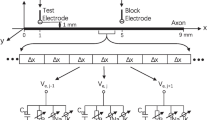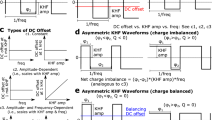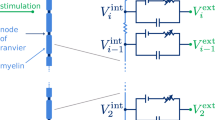Abstract
The effect of a non-symmetric waveform on nerve conduction block induced by high-frequency biphasic stimulation is investigated using a lumped circuit model of the unmyelinated axon based on Hodgkin-Huxley equations. The simulation results reveal that the block threshold monotonically increases with the stimulation frequency for the symmetric stimulation waveform. However, a non-monotonic relationship between block threshold and stimulation frequency is observed when the stimulation waveform is non-symmetric. Constant activation of potassium channels by the high-frequency stimulation results in the increase of block threshold with increasing frequency. The non-symmetric waveform with a positive pulse 0.4–0.8 μs longer than the negative pulse blocks axonal conduction by hyperpolarizing the membrane and causes a decrease in block threshold as the frequency increases above 12–16 kHz. On the other hand, the non-symmetric waveform with a negative pulse 0.4–0.8 μs longer than the positive pulse blocks axonal conduction by depolarizing the membrane and causes a decrease in block threshold as the frequency increases above 40–53 kHz. This simulation study is important for understanding the potential mechanisms underlying the nerve block observed in animal studies, and may also help to design new animal experiments to further improve the nerve block method for clinical applications.







Similar content being viewed by others
References
Bowman, B. R., & McNeal, D. R. (1986). Response of single alpha motoneurons to high-frequency pulse train: firing behavior and conduction block phenomenon. Applied Neurophysiology, 49, 121–138.
Boyce WE, Diprima RC. Elementary differential equations and boundary value problems. John Wiley & Sons Inc. 6th ed: 436–457, 1997.
Camilleri, M., Toouli, J., Herrera, M. F., Kow, L., Pantoja, J. P., Billington, C. J., Tweden, K. S., Wilson, R. R., & Moody, F. G. (2009). Selection of electrical algorithms to treat obesity with intermittent vagal block using an implantable medical device. Surgery for Obesity and Related Diseases, 5, 224–230.
Cattell, M., & Gerard, R. W. (1935). The “inhibitory” effect of high-frequency stimulation and the excitation state of nerve. Journal of Physiology, 83, 407–415.
Catterall, W. A. (2012). Voltage-gated sodium channels at 60: structure, function and pathophysiology. Journal of Physiology, 590, 2577–2589.
Cuellar, J. M., Alataris, K., Walker, A., Yeomans, D. C., & Antognini, J. F. (2013). Effect of high-frequency alternating current on spinal afferent nociceptive transmission. Neuromodulation, 16, 318–327.
Frankenhaeuser, B. (1960). Quantitative description of sodium currents in myelinated nerve fibres of xenopus laevis. Journal of Physiology (London), 151, 491–501.
Gaunt, R. A., & Prochazka, A. (2009). Transcutaneously coupled, high-frequency electrical stimulation of the pudendal nerve blocks external urethral sphincter contractions. Neurorehab. Neural Repair, 23, 615–626.
Heinbockel JH. Numerical Methods for Scientific Computing. Trafford Publishing, 2005.
Hodgkin, A. L., & Huxley, A. F. (1952). A quantitative description of membrane current and its application to conduction and excitation in nerve. Journal of Physiology (London), 117, 500–544.
Jan, L. Y., & Jan, Y. N. (2012). Voltage-gated potassium channels and the diversity of electrical signalling. Journal of Physiology (London), 590, 2591–2599.
Joseph, L., & Butera, R. (2009). Unmyelinated aplysia nerves exhibit a nonmonotonic blocking response to high-frequency stimulation. IEEE Trans Neural Syst Rehab Eng, 17, 537–544.
Joseph, L., & Butera, R. (2011). High-frequency stimulation selectively blocks different types of fibers in frog sciatic nerve. IEEE Trans Neural Syst Rehab Eng, 19, 550–557.
Leob, G. E. (1989). Neural prosthetic interfaces with the nervous system. Trends in Neurosciences, 12, 195–201.
Rattay, F. (1989). Analysis of models for extracellular fiber stimulation. IEEE Transactions on Biomedical Engineering, 36, 676–682.
Rattay, F., & Aberham, M. (1993). Modeling axon membranes for functional electrical stimulation. IEEE Transactions on Biomedical Engineering, 40, 1201–1209.
Reboul, J., & Rosenblueth, A. (1939). The action of alternating currents upon the electrical excitability of nerve. American Journal of Physiology, 125, 205–215.
Rosenblueth, A., & Reboul, J. (1939). The blocking and deblocking effects of alternating currents on nerve. American Journal of Physiology, 125, 251–264.
Roth, B. J. (1994). Mechanisms for electrical stimulation of excitable tissue. Critical Rev Biomed Eng, 22, 253–305.
Roth, B. J. (1995). A mathematical model of make and break electrical stimulation of cardiac tissue by a unipolar anode or cathode. IEEE Transactions on Biomedical Engineering, 42, 1174–1184.
Schwarz, J. R., Reid, G., & Bostock, H. (1995). Action potentials and membrane currents in the human node of Ranvier. Pflügers Archiv, 430, 283–292.
Song, D., Raphael, G., Lan, N., & Loeb, G. E. (2008). Computationally efficient models of neuromuscular recruitment and mechanics. Journal of Neural Engineering, 5, 175–184.
Tai, C., Roppolo, J. R., & de Groat, W. C. (2004). Block of external urethral sphincter contraction by high frequency electrical stimulation of pudendal nerve. Journal of Urology, 172, 2069–2072.
Tai, C., de Groat, W. C., & Roppolo, J. R. (2005a). Simulation analysis of conduction block in unmyelinated axons induced by high-frequency biphasic electrical currents. IEEE Transactions on Biomedical Engineering, 52, 1323–1332.
Tai, C., de Groat, W. C., & Roppolo, J. R. (2005b). Simulation of nerve block by high-frequency sinusoidal electrical current based on the Hodgkin-Huxley model. IEEE Trans Neural Syst Rehab Eng, 13, 415–422.
Tai, C., Roppolo, J. R., & de Groat, W. C. (2009). Analysis of nerve conduction block induced by direct current. Journal of Computational Neuroscience, 27, 201–210.
Tai, C., Guo, D., Wang, J., Roppolo, J. R., & de Groat, W. C. (2011). Mechanism of conduction block in amphibian myelinated axon induced by biphasic electrical current at ultra-high frequency. Journal of Computational Neuroscience, 31, 615–623.
Tanner, J. A. (1962). Reversible blocking of nerve conduction by alternating-current excitation. Nature, 195, 712–713.
van Buyten, J. P., Al-Kaisy, A., Smet, I., Palmisani, S., & Smith, T. (2013). High-frequency spinal cord stimulation for the treatment of chronic back pain patients: results of a prospective multicenter European clinical study. Neuromodulation, 16, 59–65.
Vasylyev, D. V., & Waxman, S. G. (2012). Membrane properties and electrogenesis in the distal axons of small dorsal root ganglion neurons in vitro. Journal of Neurophysiology, 108, 729–740.
Wattaja, J. J., Tweden, K. S., & Honda, C. N. (2011). Effects of high frequency alternating current on axonal conduction through the vagus nerve. Journal of Neural Engineering, 8, 056031.
Waxman, S. G. (2012). Sodium channels, the electrogenisome and the electrogenistat: lessons and questions from the clinic. Journal of Physiology (London), 590, 2601–2612.
Acknowledgments
This study is supported by DOD Spinal Cord Injury Program under grant W81XWH-11-1-0819 and by NIH under grant DK-068566.
Conflict of interest
The authors declare that they have no conflict of interest.
Author information
Authors and Affiliations
Corresponding author
Additional information
Action Editor: Arnd Roth
Rights and permissions
About this article
Cite this article
Zhao, S., Yang, G., Wang, J. et al. Effect of non-symmetric waveform on conduction block induced by high-frequency (kHz) biphasic stimulation in unmyelinated axon. J Comput Neurosci 37, 377–386 (2014). https://doi.org/10.1007/s10827-014-0510-z
Received:
Revised:
Accepted:
Published:
Issue Date:
DOI: https://doi.org/10.1007/s10827-014-0510-z




